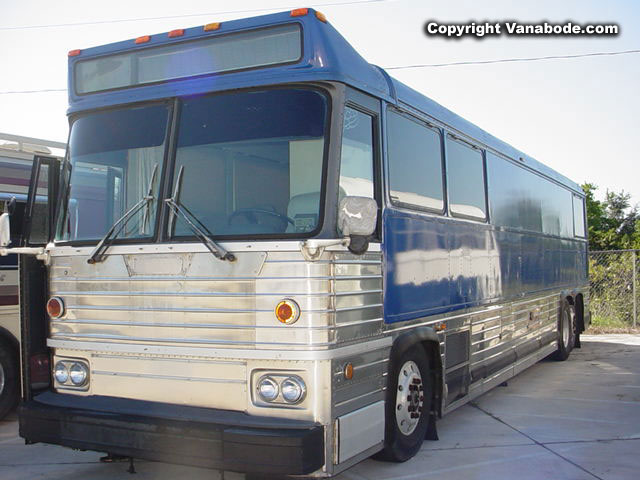
Overview Who Needs This? Excerpts Order Book Pictures Chapters
Answers Reviews Destinations Free Stuff More Contact Us
Before creating the Vanabode travel style I ran a motorcoach website. This page is one of many bus articles I wrote for coach buyers before closing that website.
Buying Used Bus
Interested in buying a used bus? Ask yourself, is it worth the money being asked? Buying a bus should be taken seriously, that's why we are going to discuss what you might be able to expect with a 20-plus ton vehicle before forking over serious cash. Prospective buyers of a used bus should know that parts and repairs can cost a great deal of money. There are tons of moving parts on a bus but limited bus repair shops. Therefore, knowing what to look for in the beginning when buying a used bus could help you avoid costly repairs down the road.
Ask why the owner is selling the bus. Find the original service manuals records. Before buying a used bus take it to a commercial diesel dealer and let them inspect the powertrain. Check out the bus at night. Check all the running lights. Turn on the generator and listen for any trouble.
Let's go over your used bus from top to bottom. You need to climb up on the roof looking carefully at the alignment of the metal panels. Check the glass panels as well if the glass windows extend up and over on top of the roof. If the bus has a clear coat look and see if it is shiny or dull and peeling or if there are bubbles near the top of the bus. Walking around to the front of the coach, look at the front windows on the drivers and passenger side. Do you see any whitening? This is a common problem with many older buses and is expensive to replace. If you see a big plastic shield on the front that is to keep rocks and bug guts off the body armor which is also a costly replacement. Does the exterior paint job look old fashioned or is it up to date with the mainstream decals. An older style may be harder to resell.
Step back a bit and look at the bottom of the coach. If you don't see a straight bottom line to the metal on the bus then there has probably been some damage. Open and shut and lock and unlock all of the compartments to make sure they open and close and lock properly. Another very important issue, do the outside compartments stay open by themselves or do you have to wedge a 2 x 4 under it to keep it open? Do you see any water stains inside the compartments? If you do then there is probably a leaking problem. While you are down there inspect the water tanks under the coach for any damage.
Bus tires are a large expense and they aren't all the same. When buying used bus inspect the tires along the inner diameter of the sidewall for tiny cracks. And check the inner drive axle tires for wear and tear. Some dealers will put on dump truck tires which only have a safety speed limit off 55 mph. If you have to buy new tires then make sure that you purchase a good name brand that has been tested and rated properly for load and speed. Typically a new set should last over 100,000 miles. However, if you park your bus then expect a shorter life span due to dry rot.
Check the engine compartment which should be clean and neat. If there is a dirty, greasy mess then it probably has not been treated well. Keep this in mind when looking at the generator compartment too. If you are buying a used bus to convert then you want to calculate the miles per year of age. A bus should have about 10,000 miles per year of age. If there are fewer miles then you could be looking at a bus that has been sitting around too long which will have dried up seals and dried out rubber. More miles means that it has been run hard and you could be looking at replacing seals and rubber components.
Now onto some inner workings of a bus or coach. Usually coaches have two separate electrical systems. One for the 12-volt electrical system which is used for lighting and a 24-volt system for starting the diesel engine. Buses before 1992 use the chassis for a floating ground instead of separate grounds from the main 110 volt breaker. Which means that you may have to rewire the ground if there are unsecure connections. Take a voltmeter and check every outlet. There is usually a mixture of both 24 volt DC and 12 volt and even some 110 volt lighting. Inspect the condition of all the batteries too for both the engine and the house.

Check the threads of all the water filtration systems. Turn on the water in the sinks, shower, and the outside taps. Go around and check for any leaks. How is the water pressure? Take the time and opportunity to check out the water tank for smells, rust and sediment. Look under all bathroom and sink cabinets for signs of leaks. How many water pumps are there and how old or new are they?
Check the heating system and air conditioning systems turning on each individually. Diesel powered hydronic systems may take awhile to produce heat but stick around to make sure it does. You may think the air conditioning system is low on freon or it could be a more expensive repair issue. Now the dash air is another system all together. It runs on a 24 volt system. Open all the vents and turn on the system for both cold air and heat. Inspect the lines from the compressor to the condensing unit for leaks.
Check the starting amperage of each electrical component of the used bus. If you are purchasing this bus to convert to use at campgrounds, keep in mind that smaller campgrounds only have 50 amps available. This means that you may not be able to run your microwave and air conditioning at the same time. Warn starting coils draw more amperage.
Let's talk about the interior of the bus. Did the previous owner smoke or have pets? The only way to get rid of pet dander and nicotine stains is to clean and paint the walls and replace all the carpet. This is very time consuming and cumbersome due to the small square footage of a bus. The fabric on the couches, seats and blinds are also a magnet for nicotine smells and pet dander. Inspect the countertops for cracks. Go over every drawer and door checking for workmanship such as staples or dovetail construction. Buses flex while in motion and just parked in the elements. You might see cracks on tile floors but that is usually not a problem. Is the stove top, oven, microwave and refrigerator in operating condition? Are they clean? Here are more detailed and higher level considerations to think about when buying a used bus.


Home
Contact Us Copyright
© 2007-2016 Free
Guide They Hate Me
Privacy
Policy Terms
and Conditions Media
Press Affiliate